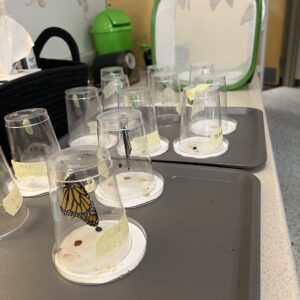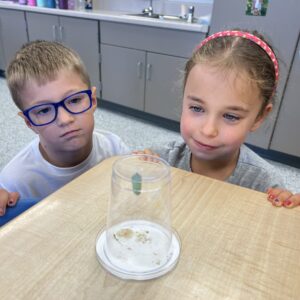
Students Raise & Release Monarch Butterflies
A Waukee CSD teacher is turning her passion for monarch butterflies into a school-wide project.
Shuler Elementary’s Monarch Butterfly Project
“We began this project on August 27 with about 140 eggs. We’ll release 95 butterflies. That is a 68% success rate. In the wild, only 5% of monarch caterpillars reach adulthood,” Julia Roegiers says.
Roegiers is a reading lab teacher at Shuler Elementary. This year, she provided eggs to 12 classrooms from first grade to fifth grade. For the first time, all fifth-grade classrooms are joining the adventure.
“I started thinking about the fifth-grade students and realized they may never have the opportunity to see a monarch butterfly emerge from a chrysalis if they don’t see it now. I was in my 50s before I ever saw it! I asked the fifth grade teachers if they would be interested and they all agreed. I promised the teachers I would provide the necessary milkweed to feed the caterpillars, take care of caterpillars/butterflies over weekends, and provide lessons they could use to teach their students,” she adds.
Monarch Release Begins
Over the past several weeks, the students have watched the butterflies transform before their eyes. Recently, many monarchs were ready to fly and head south for the winter.
“It is the ultimate learning experience for students because they take responsibility and ownership of these butterflies, even to the point of naming them,” Roegiers explains. “Students begin by seeing how small the monarch butterfly eggs are through a magnifying lens (about the size of a pencil tip). After the caterpillar emerges from its egg, students spend the next 2-3 weeks daily feeding and cleaning the frass (caterpillar poop) from the petri dish the caterpillar lives in. Students are astounded by the metamorphosis during each part of the life cycle.”
Tagging Butterflies for Research
When the butterflies are ready to fly, they are each tagged with a little sticker and released. A member of the ISU Extension team taught the student about tagging and how it helps scientists learn the path butterflies take as they head toward warmer weather.
The classes have also been learning about why it’s important to help raise monarch butterflies. In the last 20 years, the number of monarch butterflies has declined by 80%. In July 2020, the International Union for Conservation of Nature announced that monarch butterflies entered the organization’s Red List of Threatened Species as Endangered. Roegiers says everyone can help by simply planting milkweed plants.
“A monarch butterfly needs milkweed to survive. A female will only lay her eggs on a milkweed plant as that is the only type of leaf a monarch caterpillar will eat. A monarch butterfly caterpillar can eat 175–200 milkweed leaves before transforming into a chrysalis. That’s about 200 times its body weight,” Roegiers shares.
Sharing a Love for Butterflies
Roegiers says she hopes her students learn to love monarchs the same way she did — from seeing and experiencing the butterfly cycle up close.
“Two years ago, I planted a butterfly garden in my backyard and a month after I planted milkweed, I saw monarchs. I knew I had to share this adventure with students at Shuler,” Roegiers says.
As the monarchs were released and began their journey south, the pride on students’ faces was evident.
“The students’ excitement and joy in learning about monarchs makes this project worthwhile,” Roegiers says. “Watching the entire life cycle from egg to butterfly release is truly an incredible journey, and it never gets old to watch. Each year, the awe and wonder of this process amazes me.”





